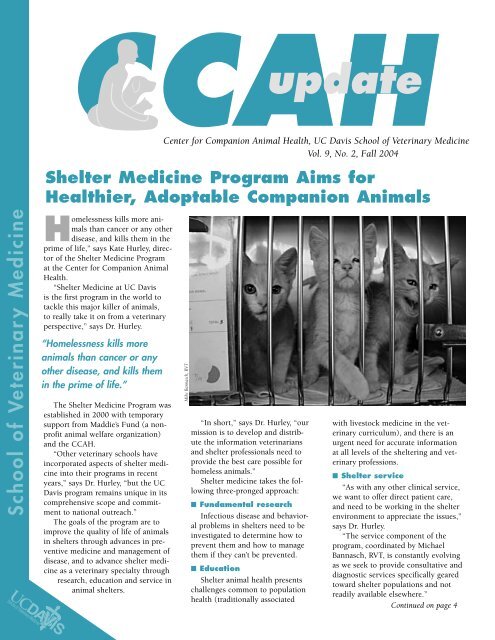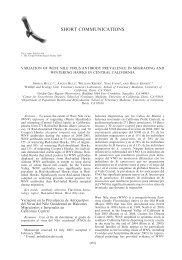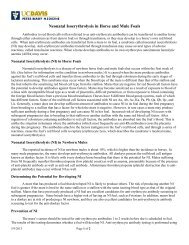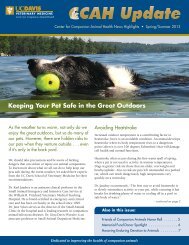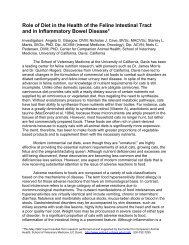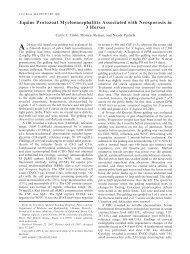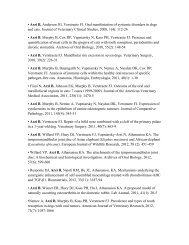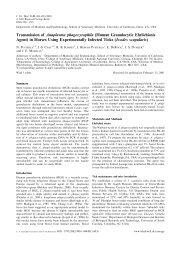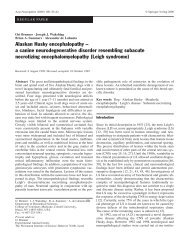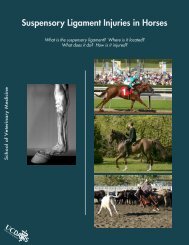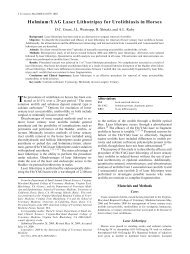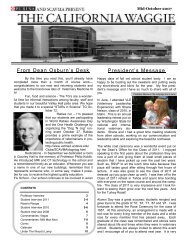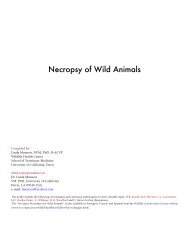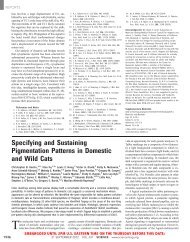CAH update C - UC Davis School of Veterinary Medicine
CAH update C - UC Davis School of Veterinary Medicine
CAH update C - UC Davis School of Veterinary Medicine
Create successful ePaper yourself
Turn your PDF publications into a flip-book with our unique Google optimized e-Paper software.
<strong>School</strong> <strong>of</strong> Veterinar y <strong>Medicine</strong><br />
C<br />
Homelessness kills more animals<br />
than cancer or any other<br />
disease, and kills them in the<br />
prime <strong>of</strong> life,” says Kate Hurley, director<br />
<strong>of</strong> the Shelter <strong>Medicine</strong> Program<br />
at the Center for Companion Animal<br />
Health.<br />
“Shelter <strong>Medicine</strong> at <strong>UC</strong> <strong>Davis</strong><br />
is the first program in the world to<br />
tackle this major killer <strong>of</strong> animals,<br />
to really take it on from a veterinary<br />
perspective,” says Dr. Hurley.<br />
The Shelter <strong>Medicine</strong> Program was<br />
established in 2000 with temporary<br />
support from Maddie’s Fund (a nonpr<strong>of</strong>it<br />
animal welfare organization)<br />
and the C<strong>CAH</strong>.<br />
“Other veterinary schools have<br />
incorporated aspects <strong>of</strong> shelter medicine<br />
into their programs in recent<br />
years,” says Dr. Hurley, “but the <strong>UC</strong><br />
<strong>Davis</strong> program remains unique in its<br />
comprehensive scope and commitment<br />
to national outreach.”<br />
The goals <strong>of</strong> the program are to<br />
improve the quality <strong>of</strong> life <strong>of</strong> animals<br />
in shelters through advances in preventive<br />
medicine and management <strong>of</strong><br />
disease, and to advance shelter medicine<br />
as a veterinary specialty through<br />
research, education and service in<br />
animal shelters.<br />
<strong>CAH</strong> <strong>update</strong><br />
Shelter <strong>Medicine</strong> Program Aims for<br />
Healthier, Adoptable Companion Animals<br />
“Homelessness kills more<br />
animals than cancer or any<br />
other disease, and kills them<br />
in the prime <strong>of</strong> life.”<br />
Center for Companion Animal Health, <strong>UC</strong> <strong>Davis</strong> <strong>School</strong> <strong>of</strong> <strong>Veterinary</strong> <strong>Medicine</strong><br />
Vol. 9, No. 2, Fall 2004<br />
Mike Bannasch, RVT<br />
“In short,” says Dr. Hurley, “our<br />
mission is to develop and distribute<br />
the information veterinarians<br />
and shelter pr<strong>of</strong>essionals need to<br />
provide the best care possible for<br />
homeless animals.”<br />
Shelter medicine takes the following<br />
three-pronged approach:<br />
■ Fundamental research<br />
Infectious disease and behavioral<br />
problems in shelters need to be<br />
investigated to determine how to<br />
prevent them and how to manage<br />
them if they can’t be prevented.<br />
■ Education<br />
Shelter animal health presents<br />
challenges common to population<br />
health (traditionally associated<br />
with livestock medicine in the veterinary<br />
curriculum), and there is an<br />
urgent need for accurate information<br />
at all levels <strong>of</strong> the sheltering and veterinary<br />
pr<strong>of</strong>essions.<br />
■ Shelter service<br />
“As with any other clinical service,<br />
we want to <strong>of</strong>fer direct patient care,<br />
and need to be working in the shelter<br />
environment to appreciate the issues,”<br />
says Dr. Hurley.<br />
“The service component <strong>of</strong> the<br />
program, coordinated by Michael<br />
Bannasch, RVT, is constantly evolving<br />
as we seek to provide consultative and<br />
diagnostic services specifically geared<br />
toward shelter populations and not<br />
readily available elsewhere.”<br />
Continued on page 4
Director’s Message<br />
Dear Friends:<br />
The fall C<strong>CAH</strong> Update emphasizes<br />
one <strong>of</strong> our newest programs—Shelter<br />
<strong>Medicine</strong>.<br />
Although a few veterinarians have<br />
dedicated their lives to shelter animal<br />
care, and many others have contracted<br />
or donated their services when needed,<br />
shelters have been largely ignored by<br />
the veterinary pr<strong>of</strong>ession.<br />
The veterinary medical community<br />
at <strong>UC</strong> <strong>Davis</strong>, however, has realized<br />
that shelter medicine is not a part-time<br />
occupation, nor something that is best<br />
learned on the job. Shelter medicine<br />
is a discipline in its own right, and as<br />
such, requires the following components—a<br />
faculty dedicated to shelter<br />
medicine; training <strong>of</strong> pr<strong>of</strong>essional<br />
students in shelter management and<br />
diseases; veterinarians with a high<br />
degree <strong>of</strong> training (i.e., residents);<br />
faculty, students and residents who go<br />
into the community and work directly<br />
with shelters <strong>of</strong> all types; research<br />
into better shelter designs; studies <strong>of</strong><br />
shelter-linked diseases and how they<br />
can best be prevented; and a thorough<br />
understanding <strong>of</strong> the social aspects <strong>of</strong><br />
pet overpopulation, pet relinquishment<br />
and pet adoption.<br />
The ultimate goals <strong>of</strong> the Shelter<br />
<strong>Medicine</strong> Program are the same as the<br />
goals <strong>of</strong> most shelters—to keep all<br />
C<strong>CAH</strong> Update, <strong>UC</strong> <strong>Davis</strong>, Fall 2004<br />
Dr. Gordon Theilen, speaking at the<br />
grand opening, is one among a handful<br />
<strong>of</strong> visionary veterinary academicians<br />
who founded the discipline <strong>of</strong> veterinary<br />
oncology in the 1960s.<br />
Dr. Theilen authored and coauthored the<br />
first textbooks in veterinary oncology<br />
and was noted for his stubborn refusal<br />
to concede to the ravages <strong>of</strong> cancer in<br />
animals. Thanks to his pioneering work,<br />
the <strong>Veterinary</strong> Oncology Service at <strong>UC</strong> <strong>Davis</strong>, now housed in the<br />
C<strong>CAH</strong>, has continued to grow in caseload, sophistication and research<br />
output, and is known for its excellence.<br />
The New C<strong>CAH</strong> Opens!<br />
The new C<strong>CAH</strong> <strong>of</strong>ficially opened July 14, 2004,<br />
with a ribbon-biting ceremony attended by<br />
many friends and companion animals.<br />
Continued on page 8<br />
animals physically<br />
and mentally healthy<br />
during their stay, and<br />
to find a loving home<br />
for every adoptable<br />
animal.<br />
Realization <strong>of</strong><br />
these goals is still in<br />
the future, but we<br />
believe that it is time<br />
for the veterinary<br />
pr<strong>of</strong>ession, through<br />
programs like this, to<br />
assume a much greater<br />
role in sheltering.<br />
The Shelter <strong>Medicine</strong><br />
Program needs your help. Start-up<br />
money from Maddie’s Fund provided<br />
us with a strong beginning, but the<br />
funds were only temporary—we now<br />
have to find alternative support.<br />
Our goal, to find the necessary<br />
funds to fully operate the program for<br />
the next six years, will require about<br />
$300,000 per year. By the end <strong>of</strong> the<br />
six years we hope to have set up a $6<br />
million shelter medicine endowment,<br />
which will then provide sufficient earnings<br />
to fund the program in perpetuity.<br />
One <strong>of</strong> the missions <strong>of</strong> the Center<br />
for Companion Animal Health is to<br />
create new programs for veterinary<br />
2<br />
Dr. Niels Pedersen welcomes clients and visitors to the new Center for<br />
Companion Animal Health. The second-floor breezeway connects the<br />
C<strong>CAH</strong> to the <strong>Veterinary</strong> Medical Teaching Hospital.<br />
medicine. I can say, as director <strong>of</strong> the<br />
C<strong>CAH</strong> and with years <strong>of</strong> experience<br />
at the school, that this is probably<br />
the most exciting, timely and relevant<br />
program undertaken by the <strong>UC</strong> <strong>Davis</strong><br />
<strong>School</strong> <strong>of</strong> <strong>Veterinary</strong> <strong>Medicine</strong> in<br />
decades.<br />
We would love to talk to you more<br />
about the Shelter <strong>Medicine</strong> Program<br />
and have you come and visit us at the<br />
C<strong>CAH</strong>. (Contact us at 530-752-7295 or<br />
www.vetmed.ucdavis.edu/ccah)<br />
Yours sincerely,<br />
Niels C. Pedersen, DVM, PhD<br />
Director, C<strong>CAH</strong><br />
Celebrants included Melanie (right), a cockatoo who resides in the Companion<br />
Avian & Exotic Service and assists in teaching avian behavior and handling.<br />
Corina Rampola/C<strong>CAH</strong>
In the Spotlight:<br />
Recognizing Our Many Companion Animal Memorial Fund Sponsors<br />
Ocean View <strong>Veterinary</strong> Hospital<br />
Pacific Grove, California<br />
Dr. Frank Kocher is chief<br />
veterinarian and owner<br />
<strong>of</strong> Ocean View <strong>Veterinary</strong><br />
Hospital in Pacific Grove, California.<br />
Located at the tip <strong>of</strong> the Monterrey<br />
Peninsula one block from the<br />
water, Ocean View deals with small<br />
animals—cats, dogs, exotic and<br />
pocket pets, a few birds and an occasional<br />
hamster or gerbil. Patient<br />
services include surgery (with board<br />
certified specialist surgeons and with<br />
staff surgeons), an in-house laboratory,<br />
ultrasound, radiology, dentistry,<br />
emergency care, a vaccine clinic<br />
(the first Saturday <strong>of</strong> every month),<br />
endoscopy and chemotherapy.<br />
Sometimes Ocean View refers animals<br />
to specialty clinics at <strong>UC</strong> <strong>Davis</strong><br />
(the <strong>Veterinary</strong> Medical Teaching<br />
Hospital and the Center for Companion<br />
Animal Health). Dr. Kocher<br />
says, “It’s a tremendous service and<br />
very cost effective for what they do<br />
at <strong>UC</strong> <strong>Davis</strong>.”<br />
Dr. Kocher is a co-author (along<br />
with an animal behavior consultant<br />
and a companion parrot consultant)<br />
<strong>of</strong> Birds <strong>of</strong>f the Perch: Therapy and<br />
Training for Your Pet Bird, published<br />
last year by Simon and Schuster.<br />
The book shows that rewarding<br />
good behavior is a compassionate<br />
way to train mischievous domestic<br />
birds to alter problem behavior. The<br />
guide also deals with choosing the<br />
right species <strong>of</strong> bird for one’s family<br />
and how to keep the animal healthy<br />
and happy.<br />
Dr. Kocher also has an interest in<br />
wild birds and is known to pull over<br />
while driving to take a closer look at<br />
a bird he spots from the highway.<br />
For five years Dr. Kocher has<br />
been a member <strong>of</strong> the Board <strong>of</strong> Governors<br />
<strong>of</strong> the California <strong>Veterinary</strong><br />
Medical Association. With a special<br />
interest in advancing the Registered<br />
<strong>Veterinary</strong> Technician pr<strong>of</strong>ession, he<br />
serves on both the RVT Task Force<br />
and the RVT Committee.<br />
Meet<br />
the Staff<br />
<strong>of</strong> Ocean View<br />
<strong>Veterinary</strong> Hospital<br />
Veterinarians: Dr. Frank Kocher (DVM, <strong>UC</strong> <strong>Davis</strong>, 1968) pr<strong>of</strong>essional interests: ophthalmology and<br />
cardiology; Dr. Karen Fenstermaker (DVM, Iowa State University College <strong>of</strong> <strong>Veterinary</strong> <strong>Medicine</strong>,<br />
1985) pr<strong>of</strong>essional interest: surgery (Dr. Fenstermaker practiced for 11 years in wildlife and exotics<br />
before joining Ocean View in 1996); Dr. Jennifer Keil (DVM, <strong>UC</strong> <strong>Davis</strong>, 2002) pr<strong>of</strong>essional interests:<br />
internal medicine and surgery; Dr. Annette Richmond (DVM, <strong>UC</strong> <strong>Davis</strong>, 1997) pr<strong>of</strong>essional interests:<br />
acupuncture, nutrition, nutraceutical support and surgery; Dr. Amanda Sharp (DVM, <strong>UC</strong> <strong>Davis</strong>, 1981)<br />
pr<strong>of</strong>essional interests: oncology and endoscopy; Dr. Molly Williams (DVM, <strong>UC</strong> <strong>Davis</strong> 1997)<br />
Managers: Donna Cousette; Roderick J.B. Gilchrist; Nancy Deyerle, RVT; Jacquelin M. Petenbrink, RVT<br />
Registered <strong>Veterinary</strong> Technicians: Jennifer C<strong>of</strong>fee, RVT; Tracy A. Cramer, RVT; Jan Fernandez, RVT;<br />
Sharon Radel, RVT; Linda Steiger, RVT; Marissa A. Young, RVT<br />
Bookkeeper: Jennie Rouch<br />
Receptionists, Assistants: Christine Clifton, Jennifer Everts, Matthew Hayes, Anna Pemberton, Nancy<br />
Reid-Sandler, Maureen Rosenberger, Alyson Singer, Maria Suarez, Sergio Suarez, Melanie Sutton,<br />
Lori Zaknich<br />
Dr. Kocher got involved with the<br />
Companion Animal Memorial Fund<br />
after a classmate told him about it.<br />
He has stayed with it because, he says,<br />
“The Companion Animal Memorial<br />
Fund is more than a charity. When<br />
a patient is remembered through the<br />
fund, everyone benefits—the client<br />
receives the expression <strong>of</strong> sympathy<br />
from the veterinarian, the C<strong>CAH</strong><br />
receives funds to support research<br />
programs, and results <strong>of</strong> the studies<br />
3<br />
may benefit other animals with a similar<br />
condition in the future.”<br />
“When a client loses an animal, we<br />
contribute immediately to the memorial<br />
fund,” says Dr. Kocher. “Receiving the<br />
letter from the C<strong>CAH</strong> in a timely manner<br />
demonstrates that we care about the<br />
pets and their owners. It also empowers<br />
the owners and the veterinarians with<br />
the knowledge that we are doing something<br />
to advance veterinary medicine<br />
and combat the scourge <strong>of</strong> disease.”<br />
C<strong>CAH</strong> Update, <strong>UC</strong> <strong>Davis</strong>, Fall 2004
In the Laboratory: Advancing<br />
Scientific Understanding<br />
Investigators at the C<strong>CAH</strong> carry out and publish scientific studies to<br />
advance our understanding <strong>of</strong> how best to care for shelter animals. Areas<br />
<strong>of</strong> interest include infectious disease prevention and management in populations<br />
(including facility design, data management, and other issues that are<br />
important to health care), and behavioral care <strong>of</strong> shelter animals to improve<br />
well-being and adoptability.<br />
FCV, FHV and FECV in Shelters<br />
N.C. Pedersen, R. Sato, J.E. Foley, and A.M.<br />
Poland carried out a study (published in<br />
the Journal <strong>of</strong> Feline <strong>Medicine</strong> and Surgery<br />
in 2004) to determine the origin and subsequent<br />
spread <strong>of</strong> feline calicivirus (FCV),<br />
feline herpesvirus (FHV), and feline enteric<br />
coronavirus (FECV) in cats relinquished to<br />
shelters.<br />
They found that the spread <strong>of</strong> all three<br />
viruses was rapid and efficient in the shelter<br />
environment. Although shelters were not the<br />
primary source <strong>of</strong> these viruses for many<br />
relinquished cats, factors intrinsic to the<br />
shelter environment were critical in amplifying<br />
shedding and spread to susceptible<br />
individuals.<br />
In particular, the speed and magnitude <strong>of</strong><br />
the increase <strong>of</strong> FHV shedding, which was<br />
very low at the time <strong>of</strong> entry, suggests there<br />
was reactivation <strong>of</strong> latent infections as well<br />
as acquisition <strong>of</strong> new infections once an animal<br />
entered the shelter environment.<br />
The Feline URI Initiative<br />
The shelter medicine program has recently<br />
launched the Feline Upper Respiratory<br />
Infection Initiative to begin addressing a significant<br />
problem for homeless cats.<br />
Feline URI, while treatable in any one cat,<br />
is a nightmare to treat in shelters, says Dr.<br />
Hurley. Cats die in shelters because <strong>of</strong> this<br />
simple infection, which is induced by stress<br />
and crowding.<br />
Because many shelters cannot effectively<br />
isolate and treat cats with URI, the animals<br />
must be euthanized. URI creates an enormous<br />
financial and emotional strain on shelters.<br />
Even if treatable, an animal must spend<br />
weeks in isolation. When people adopt a cat<br />
with URI, they may spend $200 at the vet,<br />
other cats get sick, and people lose faith in<br />
shelters and stop coming to adopt animals,<br />
which adds up to lost lives.<br />
In a few terrible cases, simple URI agents<br />
have mutated to cause killer diseases that<br />
migrate to the owned pet population. Dr.<br />
Hurley has carried out research on virulent<br />
mutant strains <strong>of</strong> calicivirus, which spread<br />
throughout the cat’s system. Signs <strong>of</strong> normal<br />
calicivirus infection are mostly upper<br />
respiratory, but sometimes include lameness,<br />
diarrhea or other conditions. In the mutant<br />
C<strong>CAH</strong> Update, <strong>UC</strong> <strong>Davis</strong>, Fall 2004<br />
form, cats experience severe swelling<br />
<strong>of</strong> the head or limbs, widespread sores<br />
and hair loss, and involvement <strong>of</strong> various<br />
organ systems.<br />
“There is currently no treatment for virulent<br />
mutant calicivirus,” says Dr. Hurley.<br />
“Vaccination does not seem to <strong>of</strong>fer any<br />
protection, and it’s very easy to spread<br />
and hard to kill. Early recognition is currently<br />
our only tool to prevent outbreaks<br />
from spreading out <strong>of</strong> control. Research<br />
from the Shelter <strong>Medicine</strong> Program has<br />
allowed cases to be quickly recognized<br />
and preventive measures have protected<br />
other cats from exposure.”<br />
“We need to know so much more,”<br />
says Dr. Hurley. “We have done a study<br />
accepted for publication (in a refereed<br />
scientific journal) that looks at 500 cats in<br />
various shelters to determine the frequency<br />
<strong>of</strong> the different viruses and bacteria<br />
that cause feline URI. Now that we have<br />
some idea <strong>of</strong> ‘what,’ we need to find out<br />
‘how much’ and ‘how bad.’<br />
“The next step in combating the problem<br />
is simply to develop a system for tracking<br />
how much URI there is in a shelter.<br />
It may seem trivial, but it is fundamental<br />
to get a handle on the problem. When<br />
shelter personnel say URI is ‘out <strong>of</strong> control’<br />
we need to know what that means,”<br />
she says.<br />
“A URI tracking project was initiated at<br />
the Sacramento SPCA. Some other shelters<br />
are collaborating (Tony La Russa’s<br />
Animal Rescue Foundation in Walnut<br />
Creek and East Bay SPCA), and we hope<br />
to expand the involvement. We want to<br />
know the number <strong>of</strong> cats with URI, how<br />
long each has been sick, the qualitative<br />
measure <strong>of</strong> severity, and how long the<br />
cat has been in the shelter.<br />
“For instance, a vaccination program<br />
might reduce the disease by 20 percent,<br />
but in order to measure success we need<br />
to have a baseline before we begin.<br />
If we can track incidence and look at<br />
the differences between infection rates<br />
in shelters and how animals there are<br />
managed (e.g., housing to reduce stress,<br />
vaccination strategies, nutrition and ventilation),<br />
we could begin to make appropriate<br />
changes to decrease the incidence<br />
<strong>of</strong> feline URI.”<br />
4<br />
Shelter <strong>Medicine</strong><br />
Continued from page 1<br />
The Shelter <strong>Medicine</strong> Program <strong>of</strong>fers<br />
consultation and population-based<br />
diagnostic services for shelters at the<br />
lowest possible cost. “Consultations<br />
include facility design, husbandry<br />
issues such as cleaning and housing,<br />
vaccination, and protocol development,”<br />
says Dr. Hurley.<br />
“…simple information can<br />
have a pr<strong>of</strong>ound effect on a<br />
shelter’s ability to take good<br />
care <strong>of</strong> its animals.”<br />
“We aim to provide shelters with<br />
evidence-based guidance on managing<br />
common shelter infections such as<br />
upper respiratory infection (URI) and<br />
diarrhea. We also assist shelters in dealing<br />
with disease outbreaks and cruelty<br />
cases, along with providing education<br />
and outreach programs.<br />
“Our goal is to create a model program<br />
<strong>of</strong> medical care for shelter animals—one<br />
that can provide hands-on<br />
training for veterinary students and a<br />
place for residents to become experienced<br />
shelter veterinarians. On-site service—by<br />
veterinarians who can provide<br />
information about policies, protocols<br />
and successful strategies—benefits the<br />
animals, shelter organizations (public<br />
and private), students and residents—<br />
not only locally, but nationally.”
“One <strong>of</strong> the most striking and satisfying<br />
things about the Shelter <strong>Medicine</strong><br />
Program, from the viewpoint <strong>of</strong> a veterinarian,”<br />
says Dr. Hurley, “is that really<br />
simple information can have a pr<strong>of</strong>ound<br />
effect on a shelter’s ability to take good<br />
care <strong>of</strong> its animals. The shelter staff<br />
members don’t need a lot <strong>of</strong> high-tech<br />
equipment—using an effective cleaning<br />
agent or making a small change in vaccination<br />
strategy can impact thousands<br />
<strong>of</strong> animals.”<br />
Objectionable behavior is one <strong>of</strong> the<br />
main reasons animals are relinquished<br />
to shelters. Veterinarians have the perfect<br />
opportunity to help prevent such<br />
behaviors from developing, and veterinarians<br />
familiar with shelter medicine<br />
and behavior can also guide clients who<br />
adopt animals from shelters.<br />
Educational Programs<br />
and Outreach<br />
Educational programs include postgraduate<br />
veterinary residencies in shelter<br />
medicine, veterinary school classes,<br />
student activities and externships in<br />
shelters, Web-based scientific resources,<br />
and lectures to veterinary, shelter and<br />
rescue groups.<br />
Clinical Expertise<br />
The residency program in Shelter<br />
<strong>Medicine</strong> gives veterinarians clinical<br />
expertise and prepares them for leadership<br />
in this emerging field <strong>of</strong> veterinary<br />
medicine.<br />
Debbie Aldridge/<strong>UC</strong> <strong>Davis</strong><br />
Dr. Kate Hurley and Dr. Cindi Delany<br />
examine a dog at the Sacramento<br />
County Animal Shelter.<br />
Dr. Hurley, DVM (1999, <strong>UC</strong> <strong>Davis</strong>),<br />
MPVM (Master <strong>of</strong> Preventive <strong>Veterinary</strong><br />
<strong>Medicine</strong>, 2003, <strong>UC</strong> <strong>Davis</strong>), became<br />
the first veterinarian to complete a<br />
residency under the Shelter <strong>Medicine</strong><br />
Program. Sheila Segurson, DVM (1996,<br />
<strong>UC</strong> <strong>Davis</strong>), has completed two years<br />
<strong>of</strong> a three-year residency in Shelter<br />
<strong>Medicine</strong> and Behavior.<br />
Since 2000, opportunities for shelter<br />
veterinarians have greatly increased—at<br />
least eight recent DVM graduates from<br />
<strong>UC</strong> <strong>Davis</strong> are now practicing shelter<br />
medicine—which is helping to supply<br />
the expanding need.<br />
Shelter <strong>Medicine</strong> in the<br />
DVM Curriculum<br />
Since the program began at <strong>UC</strong><br />
<strong>Davis</strong>, more than 200 students have<br />
taken a shelter medicine class taught<br />
by Dr. Hurley in the DVM elective curriculum.<br />
The class, also open to shelter<br />
pr<strong>of</strong>essionals, includes several guest<br />
lecturers from different backgrounds,<br />
who promote shelter medicine and also<br />
give a realistic view <strong>of</strong> what shelter veterinarians<br />
are trying to accomplish with<br />
available resources.<br />
Continuing Education<br />
Dr. Hurley and the shelter medicine<br />
team have given more than 30 continuing<br />
education presentations in the last<br />
year at veterinary and shelter conferences<br />
all over the nation, on topics<br />
such as the following: developing preventive<br />
medicine programs for shelters,<br />
management <strong>of</strong> outbreaks in shelters,<br />
canine and feline parvovirus in shel-<br />
5<br />
Michael Bannasch, RVT, and Dr. Kate<br />
Hurley examine a sick shelter kitten<br />
and take laboratory samples <strong>of</strong> the<br />
kitten’s nasal secretions to test for<br />
calicivirus, which can be a serious<br />
problem in the shelter environment.<br />
ters, recognition and control <strong>of</strong> canine<br />
distemper and virulent systemic feline<br />
calicivirus, the veterinarian’s role in recognizing<br />
and reporting animal cruelty,<br />
behavioral recommendations for newly<br />
adopted dogs, the private practitioner/<br />
technician’s role in ending euthanasia as<br />
a means <strong>of</strong> population control, and vaccination<br />
strategies for animal shelters.<br />
A Shelter <strong>Medicine</strong> Textbook<br />
The first-ever textbook is now available<br />
that covers all aspects <strong>of</strong> shelter<br />
medicine, including topics such as<br />
husbandry and care <strong>of</strong> various species,<br />
population dynamics, nutritional<br />
challenges, spay/neuter techniques and<br />
behavior programs.<br />
The book, Shelter <strong>Medicine</strong> for Veterinarians<br />
and Staff, was edited by Dr.<br />
Lila Miller and Stephen Zawistowski <strong>of</strong><br />
the ASPCA. Dr. Kate Hurley, Dr. Janet<br />
Foley and RVT Michael Bannasch—all<br />
from the C<strong>CAH</strong> Shelter <strong>Medicine</strong> Program—contributed<br />
chapters on health<br />
planning, infectious diseases and diagnostic<br />
testing, respectively.<br />
The Shelter <strong>Medicine</strong> Program is<br />
now hosting an on-line discussion<br />
group for shelter veterinarians and staff<br />
to discuss the book and better understand<br />
the challenges <strong>of</strong> animal shelter<br />
medicine.<br />
In November 2004, Dr. Hurley and Dr.<br />
Brenda Griffin from the College <strong>of</strong> <strong>Veterinary</strong><br />
<strong>Medicine</strong>, Auburn University, will<br />
receive the Alex Lewyt <strong>Veterinary</strong> Medical<br />
Center Award <strong>of</strong> Achievement from the<br />
North Shore Animal League America for<br />
their dedication to the humane treatment<br />
<strong>of</strong> homeless animals everywhere, their<br />
efforts to determine the best methods and<br />
procedures for improving the lives <strong>of</strong> all<br />
dogs and cats, and their unselfish commitment<br />
to educating others.<br />
C<strong>CAH</strong> Update, <strong>UC</strong> <strong>Davis</strong>, Fall 2004
Our Friends &<br />
Companions<br />
Dear Doctor Pedersen:<br />
We would like to thank you so much<br />
for letting us know that Dr. Suzanne Lee<br />
and her staff from Monte Vista <strong>Veterinary</strong><br />
Hospital were so thoughtful and caring to<br />
make a financial donation in memory <strong>of</strong><br />
our Kona.<br />
Kona was a “Rott-a-dor” (Rottweiller<br />
and Labrador) who we adopted from our<br />
county animal shelter, just minutes before<br />
the final walk. We were really the lucky<br />
ones to have her.<br />
Kona was protective, well-behaved,<br />
loving, compassionate and a tease. She<br />
loved opening Christmas presents for<br />
everyone including herself. If we were<br />
slow on opening ours, she was there to<br />
help. Kona loved her rabbits and always<br />
Guide Dogs<br />
Libra<br />
(1989–2004)<br />
Novato, CA<br />
Chelsea<br />
(1991–2004)<br />
Alamo, CA<br />
Kona<br />
(1993–2004)<br />
Concord, CA<br />
had a lick for them. The rabbits would walk<br />
on her and sleep with her. She was a great<br />
mom to them.<br />
In February 2004 we discovered she<br />
had lymph node cancer. Chemotherapy was<br />
advised and we tried to save her. During<br />
her weight loss and the trips to the doctors<br />
she never hesitated to lead the way into the<br />
<strong>of</strong>fice for her therapy. She waited for her<br />
medication and took it with no effort.<br />
All who met her loved her. She tried so<br />
hard to always do the right thing and never<br />
gave us a bit <strong>of</strong> a problem. Our son, Bob,<br />
C<strong>CAH</strong> Update, <strong>UC</strong> <strong>Davis</strong>, Fall 2004 6<br />
Taler<br />
(1991–2003)<br />
San Pablo, CA<br />
Dear Dr. Pedersen,<br />
Last September we lost our dog, Taler.<br />
He died <strong>of</strong> heart disease. There are no<br />
words to express our sadness and loss.<br />
Taler was a big part <strong>of</strong> our family for<br />
almost 12 years<br />
We brought him home when he was<br />
just 7 weeks old. Since then, he was<br />
always with us, including our big move<br />
from Russia. He brought so much <strong>of</strong> love<br />
and joy to our lives. He knew how much<br />
we love him.<br />
At age 9 1/2, Taler’s adrenal tumor was<br />
discovered. At <strong>UC</strong> <strong>Davis</strong>, Taler had sur-<br />
said he learned more from Kona than he<br />
did from most <strong>of</strong> the people in his life.<br />
We as a family can say the very<br />
same thing. She was truly a “teacher” <strong>of</strong><br />
patience, love, compassion and stamina,<br />
and was truly a wonderful, fun friend. We<br />
hold on to her “spirit” that is still with us.<br />
We hope and pray that what was<br />
learned from her can be passed on to<br />
other animals and her death was not in<br />
vain. We are not so naive to think we can<br />
hold on to our pets forever, but can be<br />
proud that she has perhaps been able to<br />
help doctors help other animals.<br />
Thank you for all <strong>of</strong> the great work<br />
you and your staff perform. We wish you<br />
much success in helping and curing our<br />
animal friends.<br />
Animals are truly a gift from God, and<br />
He always knows the people that want<br />
and need them the most.<br />
Thank you again from Kona’s family.<br />
Sincerely, Hank, Ginny and Bob Risser<br />
gery, which turned out to be very difficult<br />
and complicated. He survived.<br />
We are very grateful to Dr. Walsh and<br />
Dr. Nelson. Their expertise and skills,<br />
combined with Taler’s will to live, gave us<br />
two more years <strong>of</strong> wonderful companionship.<br />
Our thanks also go to Dr. London<br />
for her experience and the great, kind care<br />
<strong>of</strong> Taler during re-checks.<br />
We celebrated Taler’s 12th birthday<br />
last December, for the first time not having<br />
him with us. Please accept our donation<br />
in Taler’s memory.<br />
Sincerely, Ludmila I<strong>of</strong>fe<br />
Nobody has ever measured how much a heart can hold.
Niner was a water dog, could not get<br />
her out <strong>of</strong> the water, no matter where the<br />
water was. Ocean was the best. She is forever<br />
in our hearts, and missed so much.<br />
—John and Suzie Lewis<br />
Stupsi<br />
Summerfield, FL<br />
Niner<br />
(1988–2004)<br />
Santa Rosa, CA<br />
Rocco<br />
(1992–2003)<br />
Berkeley, CA<br />
Your gifts help to carry out the C<strong>CAH</strong> mission<br />
Thank you for supporting the Center<br />
for Companion Animal Health!<br />
One thousand three hundred generous donors contributed a total <strong>of</strong> $150,000<br />
between April 2, 2003, and June 30, 2004, for important health studies at the<br />
C<strong>CAH</strong>. Every gift is very much appreciated, even though space doesn’t permit<br />
public acknowledgement <strong>of</strong> everyone who so graciously helped.<br />
Continued on page 8<br />
“Friends <strong>of</strong> Companion Animals” Honor Roll<br />
Thank you for supporting C<strong>CAH</strong> research at the $1,000 and higher levels:<br />
Gabrielle & Kenneth Adelman<br />
Maxine Adler<br />
Gary Alvernaz<br />
Jamie Anderson<br />
Florence & Edward Aoyagi<br />
Georgia Babladelis<br />
Lesley Bates<br />
Perk Bell<br />
Eric Berg<br />
Frances Bonsal<br />
John Book<br />
Katherine & Maynard Buehler<br />
Judy & Jim Button<br />
Judith & James Caron<br />
Nancy Carter<br />
Caron Compactor Company<br />
Albert Chu<br />
<strong>Davis</strong> Dog Training Club<br />
Scott Elrod<br />
Marjorie Everett<br />
Mildred Federico<br />
Sharon & Robert Freed<br />
Traci Reynolds & Edward Freidberg<br />
Lloyd Freitas<br />
Kindy French<br />
Georges & Germain Fusenot<br />
Charity Foundation<br />
Donna Gagnon<br />
William Gleason<br />
Lawrence Goland<br />
Hillary & Tom Gough<br />
Anita Guerra<br />
Havana Brown Fanciers<br />
June Havery<br />
Ruby Hertz<br />
Suzanne Marie Hill<br />
Terri & James Hnatyszyn<br />
Ludmila I<strong>of</strong>fe<br />
Karen Jefferson<br />
7<br />
Harriet Green Kopp<br />
Susan Koret<br />
Kathleen & Edward Lahey<br />
Sandy Lerner<br />
Joy McBride<br />
MBK Foundation<br />
Elinor & Ed McConnell<br />
Lynn McLellan<br />
Deidre Merrill<br />
Naoko & Daniel Mufson<br />
Phyllis & Charles Newman<br />
November Films<br />
Carmela Anderson & Roland Ortgies<br />
Patricia & Vincent Pedroia<br />
Peninsula Community Foundation<br />
Rex Perschbacher<br />
Paul C. & Borghild T. Petersen<br />
Foundation<br />
Mary Barbara Price<br />
Kurt Ramsey<br />
Roy Rothgeb, Jr.<br />
Rita Rothman<br />
Shirley Rothman<br />
Sacramento Valley Dog Fanciers Association<br />
Sacramento Valley <strong>Veterinary</strong> Medical<br />
Association Charitable Foundation<br />
Claudia & Roger Salquist<br />
Jamie Vanica & Al Salzano<br />
Nancy Sarn<strong>of</strong>f<br />
Patricia Schmidt<br />
Shirley Sichel<br />
Sandy Black & William Sommers<br />
Anne & Laurence Stevens<br />
Mariko Sugiyama<br />
Lory & Paul Utz<br />
Donna Waldrup-Walker & Robert Walker<br />
Julie Wrigley<br />
Linda Wroth<br />
C<strong>CAH</strong> Update, <strong>UC</strong> <strong>Davis</strong>, Fall 2004
Thank You!<br />
Many thanks to everyone who helped to make the new Center for<br />
Companion Animal Health a reality.<br />
Now we can focus on what we do best—merit-based faculty research<br />
projects that continue the C<strong>CAH</strong> reputation for making new discoveries<br />
and increasing the understanding <strong>of</strong> companion animal health.<br />
Thank you for supporting the C<strong>CAH</strong> building and equipment fund<br />
at the $1,000 and higher levels:<br />
Anonymous Donor<br />
Georgia Babladelis<br />
Bearded Collie Club <strong>of</strong> the Golden West<br />
S. D. Bechtel Jr. Foundation<br />
Virginia & Ken Bennett<br />
Judith & James Caron<br />
Marguerite Chapman<br />
Janet & Jack Collins<br />
Kathleen Correia & Stephen Evans<br />
Coyote Hills Kennel Club, Inc.<br />
Claudia Dechow & Kathie Dreher<br />
Margaret Falk<br />
Donna & C. M. Galutia<br />
Glenna Gobar<br />
Charlotte Goland<br />
Steven Goldring<br />
Pam Green<br />
The Greer Family<br />
Ingrid & Reuben Hills<br />
Janet Hooper<br />
Karen Hooper<br />
Patricia Leary & Paul Huntley<br />
Kathryn Ischinger<br />
Ruth Johnston.<br />
Koret Foundation<br />
Krauss Charitable Foundation<br />
Lakeside Pet Hospital<br />
Peggy Lane<br />
LaureL Foundation<br />
<strong>CAH</strong><br />
(1409)<br />
Center for Companion Animal Health<br />
c/o Dean’s Office—Development<br />
<strong>School</strong> <strong>of</strong> <strong>Veterinary</strong> <strong>Medicine</strong><br />
University <strong>of</strong> California<br />
One Shields Avenue<br />
<strong>Davis</strong> CA 95616-8734<br />
<strong>update</strong> C<br />
ADDRESS SERVICES REQUESTED<br />
Carolyn Crosby Lundgren<br />
Maddie’s Fund<br />
Yayoi & Jon Musicant<br />
Terrance McGinnis<br />
Phyllis & Charles Newman<br />
Eugenie B. Omberg Estate<br />
Robin & Gerald Parsky<br />
Geraldine & Niels Pedersen<br />
Penultima Foundation<br />
Paul C. & Borghild T. Petersen Foundation<br />
Michael Rubin<br />
Rumsey Band <strong>of</strong> Wintun Indians<br />
Lydia Schulerud Estate<br />
Jane & Gary Schultz<br />
Mary Silan Seawright<br />
Shirley Sichel<br />
Mark Sklar<br />
Ann & Laurence Stevens<br />
Frances & Larry Stidham<br />
Carolyn & Gordon Theilen<br />
Marion Trentman & Robert Morelli<br />
Hans & Marion Ury Estate<br />
The George & Lena Valente Foundation<br />
The Wayne & Gladys Valley Foundation<br />
Stacy Baba & James Vokac<br />
Wallis Foundation<br />
Linda Wark<br />
Julie Ann Wrigley<br />
Linda Wroth<br />
The new C<strong>CAH</strong> houses clinics and clinical research in<br />
the same building—to facilitate interactions between<br />
clinicians, clients, patients and researchers. The keys<br />
to solving disease problems lie within the animals<br />
that suffer disease, but the actual unlocking requires<br />
sophisticated and intuitive laboratory study. The genetics<br />
and oncology laboratories <strong>of</strong> the new C<strong>CAH</strong> building<br />
are large, fully equipped and shared by faculty<br />
and staff—many different thinkers in the same space<br />
maximize the chances that answers will be found.<br />
Jessie, canine<br />
companion <strong>of</strong> the<br />
Duffield family,<br />
bites the ribbon<br />
<strong>of</strong> hot dog links<br />
to <strong>of</strong>ficially open<br />
the new C<strong>CAH</strong>.<br />
A large reception<br />
area serves clients<br />
<strong>of</strong> the cancer clinic<br />
and several other<br />
hospital services.<br />
The Center for Companion Animal Health (C<strong>CAH</strong>) is dedicated to advancing studies<br />
in veterinary medicine—including new ways to prevent, diagnose and treat diseases<br />
such as cancers, genetic and immune disorders, infectious diseases, kidney and heart<br />
diseases, and nutritional disorders in companion animals.<br />
C<strong>CAH</strong> Update is published by the <strong>UC</strong> <strong>Davis</strong> <strong>School</strong> <strong>of</strong> <strong>Veterinary</strong> <strong>Medicine</strong>,<br />
Bennie I. Osburn Dean, Niels C. Pedersen C<strong>CAH</strong> Director, Sharon Anglin and<br />
Celeste Borelli Executive Producers, Susan Donahue Editor. C<strong>CAH</strong> Update is also<br />
available online (www.vetmed.ucdavis.edu/ccah). Articles <strong>of</strong> interest may be<br />
reprinted in breed magazines and newsletters with the following credit: “Reprinted<br />
from C<strong>CAH</strong> Update (include Vol. and No.), Center for Companion Animal Health,<br />
<strong>UC</strong> <strong>Davis</strong>.”<br />
Nonpr<strong>of</strong>it Org.<br />
U.S. Postage<br />
PAID<br />
<strong>UC</strong> <strong>Davis</strong><br />
Vickie Gustafson/VM Dean’s Office


